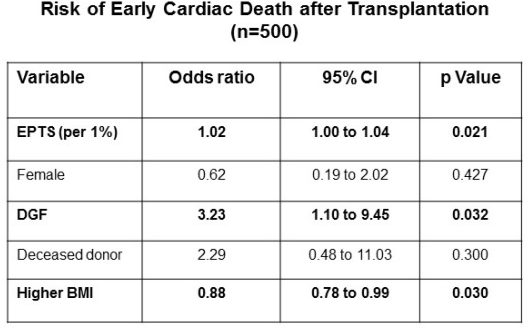Predicting Early Cardiac Death After Kidney Transplantation.
K. Balabhadrapatruni, A. Liu, N. Sarabu, E. Sanchez, J. Augustine.
Medicine, University Hospitals Case Medical Center, Cleveland, OH.
Meeting: 2016 American Transplant Congress
Abstract number: B209
Keywords: Kidney transplantation, Mortality
Session Information
Session Name: Poster Session B: Kidney: Cardiovascular and Metabolic
Session Type: Poster Session
Date: Sunday, June 12, 2016
Session Time: 6:00pm-7:00pm
 Presentation Time: 6:00pm-7:00pm
Presentation Time: 6:00pm-7:00pm
Location: Halls C&D
Background: Early cardiac mortality is a devastating occurrence after transplantation. We sought to analyze risk factors and patient characteristics, including the estimated post transplant survival (EPTS) score, associated with increased risk of early cardiac death following kidney transplantation.
Methods: We analyzed 500 consecutive kidney recipients between 1/06 and 12/12, and defined early cardiac death (CD) as occurring within three years from transplantation. EPTS scores were calculated for all patients from the time of transplantation.
Results: Eighteen patients (4%) were identified as having CD, and of these, eight died within six months of transplantation. Pretransplant nuclear stress testing was negative for ischemia in all patients except one who underwent cardiac revascularization prior to transplantation. Baseline diabetes was present in 56% of CD patients vs. 32% of the remaining cohort (p=0.033). There were also trends for older age (55±11 vs. 50±13) and longer dialysis vintage (59±35 vs. 44±40) in CD patients. The EPTS score, which accounted for all of these variables, was a median of 56% (range 5-97) in CD patients vs. 39% (range 1-99) in the remaining cohort (p=0.003). In the eight patients with CD within six months of transplant, the EPTS score was even higher with a median of 85% (range 55-98). In addition, CD patients had a trend for lower BMI at transplant, a lower percentage of female gender, a higher rate of deceased donor transplant, and a higher rate of delayed graft function (DGF). Logistic regression analysis for the risk of CD is shown in the Table. In this model, higher EPTS score, DGF, and lower BMI at transplantation all predicted CD.
Conclusion: In this analysis of early cardiac death after kidney transplantation, nuclear cardiac imaging did not appear predictive of CD. The EPTS score, along with DGF and lower BMI, was predictive after controlling for other factors and was particularly high in patients with CD within six months of transplant. Patients with a high EPTS score should have aggressive attempts at risk reduction after transplantation, and this may include avoiding allografts at high risk for DGF.

CITATION INFORMATION: Balabhadrapatruni K, Liu A, Sarabu N, Sanchez E, Augustine J. Predicting Early Cardiac Death After Kidney Transplantation. Am J Transplant. 2016;16 (suppl 3).
To cite this abstract in AMA style:
Balabhadrapatruni K, Liu A, Sarabu N, Sanchez E, Augustine J. Predicting Early Cardiac Death After Kidney Transplantation. [abstract]. Am J Transplant. 2016; 16 (suppl 3). https://atcmeetingabstracts.com/abstract/predicting-early-cardiac-death-after-kidney-transplantation/. Accessed December 19, 2025.« Back to 2016 American Transplant Congress
